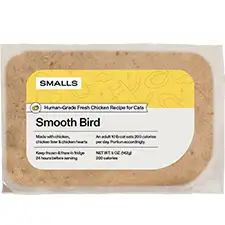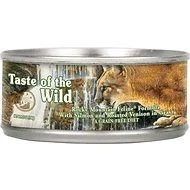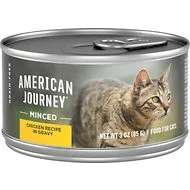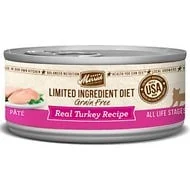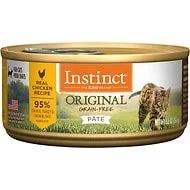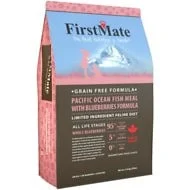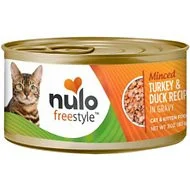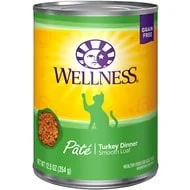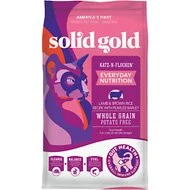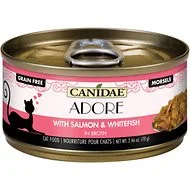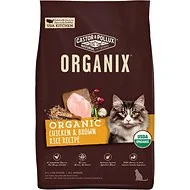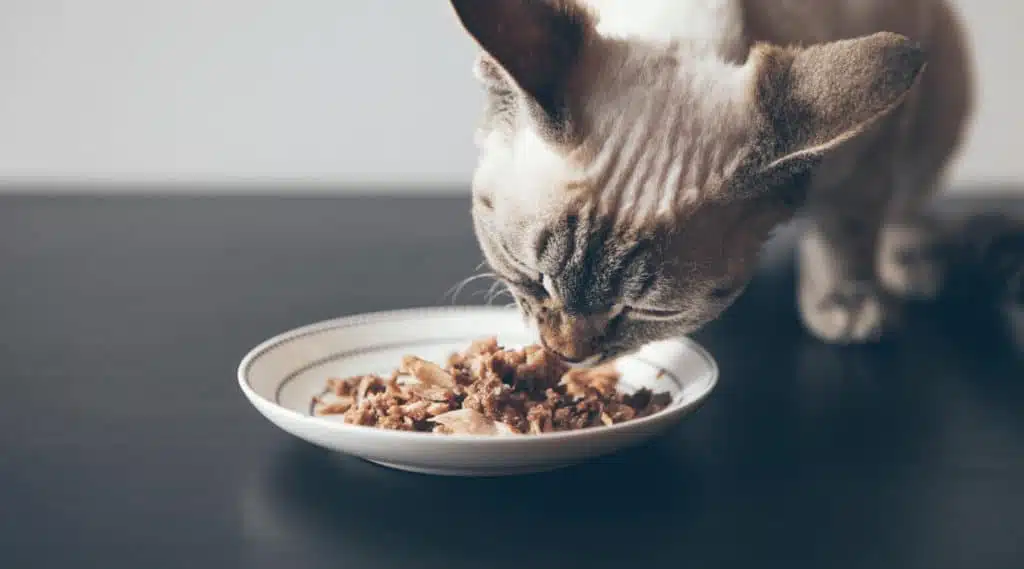11 Best Cat Foods for Firm Stools (Diarrhea) in 2025
Quick Guide
- 11 Best Cat Foods for Firm Stools
- Smalls Smooth Bird Fresh Cat Food
- Taste of the Wild Rocky Mountain Grain-Free Canned Food
- American Journey Minced Chicken Recipe in Gravy
- Merrick Limited Ingredient Grain-Free Real Turkey Pate Recipe Canned Food
- Instinct by Nature’s Variety Original Grain-Free Recipe with Real Chicken
- FirstMate Pacific Ocean Fish Meal with Blueberries Formula LID Grain-Free Dry Food
- Nulo Freestyle Minced Turkey & Duck in Gravy Grain-Free Canned Food
- Wellness Complete Health Turkey Formula Grain-Free Canned Food
- Solid Gold Katz-n-Flocken Lamb & Brown Rice Recipe with Pearled Barley Whole Grain Dry Cat Food
- Canidae Adore Salmon & Whitefish in Broth Canned Cat Food
- Castor & Pollux Organix Chicken & Brown Rice Recipe Dry Food
- What is Your Cat’s Stool Telling You?
- Treatment for Diarrhea and Loose Stools in Cats
- What to Look for in a Good Cat Food for Firm Stools
- How Do We Make Our Recommendations?
- Frequently Asked Questions
If your cat’s diarrhea is caused by an underlying health problem, your veterinarian is the best person to suggest a course of treatment. If you’re simply looking for a product to help firm up your cat’s stool by improving his digestion, we have some options you should consider. Here are our top picks for the best cat food for diarrhea and loose stools:
11 Best Cat Foods for Firm Stools
Smalls Smooth Bird Fresh Cat Food
Overall Best Cat Food for Firm Stool: If you want your cat to have firm, healthy stools you need to feed him cat food that is highly digestible. Real, whole-food ingredients are the most digestible and fresh food is best, if you can afford it. Smalls is our top choice for the best fresh cat food company and they send it right to your door. Not only does Smalls use all-natural ingredients, but their recipes are packed with nutrition, high in moisture, and prepared in small batches to ensure nutritional quality. You simply provide some information about your cat’s breed, age, weight, and activity level then they calculate his calorie needs and send you pre-portioned packages of fresh food customized to those requirements. Every recipe starts with a premium source of animal protein and is complete and balanced for optimal nutrition.
- Pros: Fresh food sent to your door, real whole-food ingredients, rich in protein and moisture, highly digestible recipes, complete and balanced nutrition, customized calorie content
- Cons: Only two recipes to choose from, significantly more expensive than traditional kibble
Taste of the Wild Rocky Mountain Grain-Free Canned Food
Most Popular Cat Food for Firm Stool: When you can’t decide what to feed your cat, you can always go with a trusted brand like Taste of the Wild. This brand uses premium roasted meats as the foundation for all of their recipes with other whole-food ingredients including fresh fruits and vegetables as well as grain-free carbohydrates. This Rocky Mountain canned food recipe features fresh salmon as the main ingredient with chicken liver, chicken, smoked salmon, and roasted venison as supplemental proteins. You’ll find plenty of omega-3 and omega-6 fatty acids for healthy skin and coat with fresh fruits and vegetables to provide digestible sources of key nutrients. Overall, the recipe is complete and balanced with the help of vitamin supplements and chelated minerals.
- Pros: Real animal proteins, high in moisture and flavor, fresh fruits and vegetables, complete and balanced nutrition, chelated mineral supplements, highly digestible
- Cons: May be too high in fiber for some cats, contains several starchy ingredients
American Journey Minced Chicken Recipe in Gravy
Most Affordable Cat Food for Firm Stool: If your cat suffers from loose stool, you may want to increase the quality of his diet to improve its digestibility. High-quality cat food can be expensive, but this American Journey Minced Chicken Recipe in Gravy is very affordable. It still features a real animal protein as the main ingredient but is priced under $1 per can. This recipe contains carefully selected ingredients in a complete and balanced formula fortified with vitamins and chelated mineral supplements. It also contains a rich blend of omega-3 and omega-6 fatty acids for skin and coat support with supplemental taurine for immune health and heart health. Measured as dry matter, this recipe contains 50% protein and 22% fat.
- Pros: Priced under $1 per can, real source of protein first ingredient, rich in natural flavor and moisture, digestible grain-free carbohydrates, rich blend of omega fatty acids, chelated mineral supplements
- Cons: Some cats may be sensitive to chicken
Merrick Limited Ingredient Grain-Free Real Turkey Pate Recipe Canned Food
Best Cat Food for Firm Stool and Sensitive Stomach: Cats with chronic food allergies often present with skin-related symptoms like itchy skin and recurrent ear infections. In some cases, however, cats also develop digestive symptoms. If your cat has chronic diarrhea, it may be the result of something in his diet and you should consider a limited ingredient diet to eliminate the ingredients causing his sensitivity. This Merrick LID Grain-Free Real Turkey Pate is a great option because it contains fresh turkey as a single source of protein that is novel for many cats. It is completely grain-free and free from common allergens like fillers and by-products, plus it is complete and balanced for all life stages. Measured as dry matter, this recipe contains 41% protein and 23% fat.
- Pros: Limited number of ingredients, single source of novel protein, digestible grain-free recipe, rich in moisture and natural flavor, blend of omega fatty acids, complete and balanced for all life stages
- Cons: Contains some plant proteins (pea protein and alfalfa meal)
Instinct by Nature’s Variety Original Grain-Free Recipe with Real Chicken
If you’re looking for a protein-rich, highly digestible cat food for your cat, consider this Instinct by Nature’s Variety Original Grain-Free Recipe. It features cage-free chicken as the first ingredient with a total of 81% real animal ingredients and healthy fats with 19% fruits, vegetables, and supplements. It contains guaranteed levels of probiotics for optimal digestion and a rich blend of omega fatty acids for healthy skin and coat. Overall, it provides 41% protein and 21% fat at 505 calories per cup.
FirstMate Pacific Ocean Fish Meal with Blueberries Formula LID Grain-Free Dry Food
Another excellent option in dry food for cats with digestive issues is this FirstMate Pacific Ocean Fish Meal with Blueberries Formula. It is a limited ingredient formula featuring Pacific Ocean fish meal as a single source of novel protein with potatoes and whole blueberries as the only carbohydrates. This recipe contains just four main ingredients, limiting the potential for triggering food allergies and sensitivities, but is fortified with vitamins and chelated minerals for nutritional balance. It also contains prebiotic fibers to help ensure healthy and regular digestion.
Nulo Freestyle Minced Turkey & Duck in Gravy Grain-Free Canned Food
If you’re looking for a cat food rich in moisture and made with novel proteins, this Nulo Freestyle Minced Turkey & Duck in Gravy recipe could be a good option. It features fresh turkey as the primary protein and main ingredient with turkey liver, egg whites, and fresh duck as supplemental sources of protein. This recipe is highly digestible with whole-food ingredients like carrots and peas with ground flaxseed as a rich source of essential fatty acids. This recipe also contains essential vitamins and chelated mineral supplements to ensure complete and balanced nutrition for cats and kittens.
Wellness Complete Health Turkey Formula Grain-Free Canned Food
Complete and balanced nutrition is important for all cats, but especially for cats with digestive issues. Whole-food ingredients are the key and there are plenty of them in this Wellness Complete Health Turkey Formula. This recipe features fresh turkey as the main ingredient with chicken liver and chicken as supplemental sources of animal protein. With chicken broth next on the list, this recipe is rich in moisture and natural flavor. It also contains carrots and cranberries as rich sources of nutrients with vitamin and chelated mineral supplements to ensure nutritional balance.
Solid Gold Katz-n-Flocken Lamb & Brown Rice Recipe with Pearled Barley Whole Grain Dry Cat Food
Some cats simply prefer dry food which makes this Solid Gold Katz-n-Flocken Lamb & Brown Rice Recipe with Pearled Barley a great option. It features fresh lamb as the first ingredient with chicken meal, ocean fish meal, and eggs for supplemental protein. It is a whole-grain recipe features digestible ingredients like pearled barley and brown rice as the primary carbohydrates in addition to being rich sources of dietary fiber. This recipe contains ground flaxseed and salmon oil to ensure the optimal blend of omega-3 and omega-6 fatty acids, plus it contains probiotics for healthy and regular digestion.
Canidae Adore Salmon & Whitefish in Broth Canned Cat Food
If your cat suffers from food allergies or sensitivities, you need a highly digestible diet made with all-natural ingredients. This Canidae Adore Salmon & Whitefish in Broth Canned Cat Food is a good choice because it contains real, whole-food ingredients and it is rich in moisture for optimal digestion. This recipe features fresh salmon, tuna, and whitefish as the primary ingredients with digestible grain-free carbohydrates like sweet potatoes and carrots. It is supplemented with vitamins and chelated minerals for complete and balanced nutrition and it has a high moisture content of 83%.
Castor & Pollux Organix Chicken & Brown Rice Recipe Dry Food
If you’re going to feed your cat dry food, make sure it is one made with premium-quality ingredients to ensure optimal digestion and nutrient absorption. This Castor & Pollux Organix Chicken & Brown Rice Recipe is a great choice because it contains organic ingredients like free-range chicken, oatmeal, and brown rice. With whole grains for digestible carbohydrates, this recipe is rich in fiber and it is supplemented with probiotics for healthy digestion as well. It contains a rich blend of omega-3 and omega-6 fatty acids for healthy skin and cat, plus it is higher in moisture than the average kibble at 11%.
What is Your Cat’s Stool Telling You?
Keeping your cat’s litter box clean is important. No one likes to use a dirty bathroom and your cat is the same. Plus, keeping the litter box clean limits odor that can easily pervade your house. As unpleasant a task as it may be, scooping the litter box is an essential one and you shouldn’t rush through it.
According to Smalls, it is crucial that you take the time to check your cat’s stool once in a while. The characteristics of your cat’s stool and any changes in those characteristics can tell you a lot about his health. Changes in your cat’s bowel movements are often the first indication of a problem and should not be ignored. The four primary characteristics in your cat’s stool that you should pay attention to are the color, consistency, contents, and smell.
- Color – Healthy stools are a deep brown color (like a chocolate bar!). Yellow stool suggests liver or gallbladder problems while red stools signify damage to the colon or lower gastrointestinal track. Black, tarry stools mean blood in the digestive tract, often from a stomach ulcer.
- Consistency – Normal stools are firm but not hard and shaped like a sausage. Rock-hard stools and stools that look more like pellets are often a sign of dehydration or lack of fiber in the diet. Stools that are too soft or with an undefined shape are abnormal as well.
- Contents – For the most part, your cat’s stool should be uniform in texture and without much undigested food. You may see some hair in the stool occasionally as well, though large amounts of hair could signal a skin problem. White flecks in the stool may be a sign of parasite infection.
- Smell – Cat poop has a pretty distinctive smell that is unpleasant but not foul. Changes in the odor of your cat’s stool can indicate a problem, especially when paired with other symptoms.
Now that you have a better understanding of what healthy stool looks like, you may find yourself taking a second look into your cat’s litter box. If you notice piles of loose stool rather than firm, solid pieces, you may want to dig a little deeper to see if your cat might be sick.
Treatment for Diarrhea and Loose Stools in Cats
If you notice changes in the consistency of your cat’s stool, you may want to take some time to consider the potential causes. Occasional diarrhea in cats is generally nothing to worry about and resolves on its own, but chronic diarrhea could be an indication of a serious health problem. Chronic diarrhea generally means that your cat has been having loose stools for three weeks or more – a day or two of diarrhea may be nothing to worry about.
Some of the most common causes of chronic diarrhea in cats include the following:
- Viral infection
- Bacterial infection
- Intestinal parasites
- Food intolerance or allergy
- Certain medications
- Ingestion of toxic substances
- Liver or kidney disease
- Pancreatic disease
- Overactive thyroid gland
- Malnourishment or malabsorption
If your cat has been having diarrhea, you may be wondering whether it is necessary to take him to the vet. In cases where the case is not vomiting and seems to be eating and drinking normally, you may have nothing to worry about. At this point, an at-home cat loose stool remedy may be sufficient. If your cat is very young, very old, or has an underlying health problem, however, you may want to see your vet. Profuse diarrhea, bloody stools, or diarrhea paired with lethargy, vomiting, or pain are also cases where you should take your cat to the vet.
When it comes to cat diarrhea treatment, there are several things you can try. First and foremost, ask yourself if you’ve made any recent changes to your cat’s diet – these can trigger digestive upset and may resolve if you switch back to the old food. Cat loose stool and diarrhea can also be the result of inadequate fiber content or, on the flip side, too much fiber in the diet. In cases where your cat has a large volume of stool but only occasional diarrhea, a highly digestible low-fiber diet may be best. If your cat defecates frequently but only in small volumes, a higher fiber diet might work.
In addition to making adjustments to your cat’s diet, you should also encourage him to drink more water. Diarrhea and loose stools can dehydrate your cat, so provide plenty of fresh water to encourage him to drink. You might also add broth or a wet food topper to his kibble to increase moisture intake.
What to Look for in a Good Cat Food for Firm Stools
Your veterinarian is the best person to ask about the underlying causes of chronic diarrhea in cats. After assessing your cat’s situation, your vet will be able to recommend a course of treatment that may involve dietary changes. If you’re considering changing your cat’s diet, be sure to transition him slowly from one food onto another to prevent further digestive upset. Make sure whatever food you choose is made from high-quality ingredients in a highly digestible, nutritionally balanced formula.
Here are some general things to look for in a good cat food for firm stools:
- Natural whole-food ingredients. The closer your cat’s food is to nature, the better his body will be able to digest it. Real, whole-food ingredients like animal proteins (meat, poultry, and fish) and fresh fruits and veggies are the best sources of nutrients. Avoid fillers and by-products.
- Digestible carbohydrates. The carbohydrate content of your cat’s diet should be limited (protein is more important) but the ingredients that are included should be digestible. Unless your cat is allergic to grains, whole grains are very digestible as are fresh vegetables.
- Hypoallergenic and easy to digest. If your cat’s digestive issues are linked to food allergies or sensitivities, look for a hypoallergenic recipe. Hypoallergenic simply means unlikely to trigger an allergy, so you’ll need to find a recipe that doesn’t contain whatever your cat is allergic to. If you’re not sure, try a limited ingredient diet made with a novel source of protein.
- Higher moisture content. If your cat has loose stools, he may be at risk for dehydration. Increasing the moisture content of your cat’s diet is a good idea and it will also make the food easier for his body to digest properly.
- Supplemented with probiotics. Dried fermentation products are what you’re likely to see on a list of ingredients – that is simply another term for probiotics. Probiotics are beneficial bacteria that help your cat digest his food and absorb the nutrients more efficiently and completely.
Now that you have a better understanding of hyperthyroidism in cats and the role diet may play in your cat’s treatment, you’re ready to start shopping. If you need additional guidance, check out our top picks below but read how we make our recommendations first.
How Do We Make Our Recommendations?
We would never recommend something to you that we wouldn’t be happy to feed our own cats. The first thing we look for is a real source of animal protein. Cats are obligate carnivores which means that they have a biological requirement for a high-protein diet. Their ability to digest plant ingredients is limited, so we also favor recipes with low-to-moderate carbohydrate content from highly digestible sources like whole grains and vegetables. We also look for healthy animal-based sources for essential fatty acids and beneficial supplements like vitamins, chelated minerals, and probiotics.
Here are some of the requirements for a cat food to receive our recommendation:
- A source of high-quality animal protein as the first ingredient
- At least 30% crude protein for kittens and at least 26% for adults
- A minimum of 9% crude fat for kittens and adults
- A balance of omega-3 and omega-6 fatty acids, primarily from animal sources
- A rich blend of nutrients from natural sources and supplements, as needed
- Limited carbohydrate content from digestible sources (like whole grains and veggies)
- No low-quality fillers, by-products, or artificial additives (preservatives, dyes, or flavors)
Frequently Asked Questions
- Should cat poop be hard or soft? Neither! Your cat’s stool should be firm but not hard, and not too soft. Hard, small pieces of poop are considered abnormal and may be an indication of constipation. On the other side of the issue, loose or runny stools are typically a sign of diarrhea and may indicate a number of digestive issues. When it comes to your cat, loose stool is just as abnormal as hard stool.
- What can I give a cat for runny poop? The best way to determine the proper cat diarrhea treatment is to talk to your veterinarian. Your vet will be able to diagnose the underlying cause of your cat’s loose stools and tell you how to resolve it. A cat loose stool remedy may be as simple as feeding him bland foods (like white rice or chicken) for a few days to settle his stomach or might require a more long-term treatment such as a change in diet. Generally speaking, the more digestible your cat’s food is, the better he’ll be able to process it and he won’t suffer from as much diarrhea.
- Why is my cat poop soft and smelly? Your cat’s stool should be firm, not soft, and may have an unpleasant odor but shouldn’t be foul. If your cat’s stool changes in consistency or smell, it could be an indication of an underlying health problem. In many cases, soft and smelly stool indicates a problem with bacteria in the digestive tract. It could also be related to something your cat has eaten.
- Will cat diarrhea go away on its own? In many cases, occasional diarrhea in cats resolves on its own. It could be that your cat ate something he shouldn’t have or he’s going through a period of stress. If the diarrhea becomes a chronic issue, you may want to talk to your veterinarian. Untreated diarrhea can lead to dehydration and other problems which may be more severe in kittens and older cats than in healthy adult cats.
- How much should I feed my cat? Most cats do well on two meals a day – this helps keep their digestion regular and ensures that their nutritional needs are met. To determine how much to give your cat at each feeding, refer to the feeding instructions on the package. Use your cat’s age and weight to determine his daily portion then divide it into two feedings, one in the morning and one in the afternoon or evening.
No one wants to spend a lot of time examining their cat’s stool, but making the occasional check is a good idea. Changes in your cat’s stool can indicate any number of health problems, some of which can become serious if left untreated. If your veterinarian diagnoses your cat with some kind of condition, you need to treat the condition promptly. In other cases, all your cat may need is a change of diet to something more digestible.
If you’re having trouble picking a new diet for your cat, take what you’ve learned here and put it to use when you start shopping. You can also simply choose one of our top picks for the best cat food for diarrhea reviewed above.


